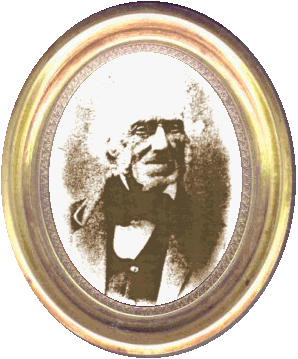Home
Contents
Index
Bottom
Main Entry
Edwin Boultbee (1790 - 1868)
(written by the Editors)
TPB only gives basic information of Edwin's
life, -- birth, emigration to Tasmania, marriage and death. It is now
possible to give a detailed account.
In 1798 his parents moved from Oxfordshire to a farm
near Bunny in Nottinghamshire which was leased from his father's
brother-in-law Sir Thomas Parkyns. Edwin was then the eldest surviving
son, four brothers having died in infancy. There the family lived until
about 1818. Edwin then took up a lease of Plas Newydd Farm, Anglesey,
from the Marquis of Anglesey. This venture, however, failed and hearing
of good prospects for farming in Tasmania he decided to emigrate. His
father had died at Plas Newydd in 1821 and his mother was looked after
by the two next brothers, first by Joseph Bage, and then by Thomas. Of
his four brothers only John, the youngest, had not settled down and he
agreed to Edwin's suggestion that they should emigrate together.
On 9th March, 1823, they sailed from the Downs in the Brig Woodlark,
Edwin as a cabin passenger, but John even with help from Edwin, could
only afford steerage accommodation. They arrived at Hobart, Tasmania, on
8th July.
Edwin had come armed with a letter of
recommendation for a grant of land from the Colonial Secretary, Lord
Bathurst, and a testimonial signed by prominent Nottinghamshire men.
These he submitted to the Lieutenant Governor with a statement of the
money and goods he brought with him. Although the total value was less
than the minimum of £500, a large sum for those days, normally required
from settlers for a land grant, Edwin's application was successful and
he was allocated 500 acres at St. Paul's River, a remote area in the
northeast quarter of the island, much troubled by stealing of livestock
by bush rangers, and wandering dispossessed aboriginals.
However, Edwin did not
immediately take up the St. Paul's River land and he farmed first at
Clarence Plains, a more settled and fertile area near Hobart which he
probably only leased. By 1824 he had been appointed Chief Constable for
the district and also Poundkeeper. The duties of these appointments
included keeping a weekly muster of all convict servants and coping with
crop-destroying wild cattle. [Pounds were enclosures for rounding up stray cattle.]
On 4th January, 1825, Edwin married Mary
Allen at St. David's Church, Hobart. She had been a fellow passenger on
the Woodlark, emigrating with the Parramore family, Mrs.
Parramore being her aunt. Prior to her marriage, Mary lived with them at
Ross Bridge, where Mr. Parramore had taken up land. Shortly after their
arrival at Hobart, Mary wrote a long letter dated 29th July, 1823, to
friends at home. This describes the voyage and also gives a most
interesting picture of early settler life. (See Appendix 4.)
In 1829, Edwin and Mary with their first two
children, Mary and Joseph Francis then very young, finally moved from
Clarence Plains to St. Paul's River to take up his reserved land. They
lived first in a house built of rammed earth with timber out-buildings.
This house was followed by a stone one built with convict labour. It was
named Rock House after one which Edwin's father had lived in near
Burton-on-Trent, Staffordshire. It is evident that the protection of a
stone house as soon as possible was necessary as the following anecdote
preserved by the Reverend Henry Travis Boultbee (1856 - 1940), third son
of JB by his first wife, illustrates:-
| On one occasion, when Edwin was
away from home, the house was about to be attacked by a party of
aboriginals. Mary ordered a lot of noise to be made and for the servants
to change their clothes to give the impression of more defenders, which
successfully prevented the attack.
|
Of Rock House itself nothing now remains but
the two end walls of neatly cut stone with chimney projections. However,
these were reused in the modern construction of accommodation for
sheep-shearers. The house must have been initially of quite modest size,
perhaps in the interests of building it as quickly as possible. We can
surmise that it would have consisted of a kitchen, living-room and three
bedrooms. It would also have needed at least a washhouse and wood
store. These may have been attached at the rear, or separate. The
servants would probably have had separate detached quarters. The modern
farm house is slightly to the east.
Five more children were born at Rock House
-- Edwin, Sarah, George Parkyns, Ellen, and Martha who died in infancy.
(For the surviving children and their descendants see Additional Chapter XII).
By 1856 Edwin's land holding had increased
to 1300 acres. He had added to the original reserve of 500 acres two
further adjoining lots, 100 acres and 700 acres. The St. Paul's River
forms the northern boundary, the land is flat and bounded on the south
and east by low hills. The present farm is still a sheep station as it
was in Edwin's time, and is even now remote.
Edwin died in 1868 and was buried in the
middle of a field near the house under a tree approximately equidistant
between the river and the southern hills. His grave is marked only by a
headstone. This has an elegant curving moulding at the top beneath which
is a scroll of formal foliage. The inscription in well-carved lettering
reads:--
|
In
Memory of
EDWIN BOULTBEE
who died
30th June 1868
aged 78
"Blessed are the dead who die
in the Lord."
|
Mary died in 1876 in her 81st year, at Rock House.
Main Entry
Home
Contents
Index
Top
©

